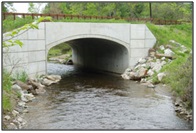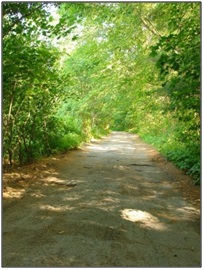Roads
Roads and NPS Pollution

Roads, highways, and bridges are a significant source of nonpoint source (NPS) pollution to Massachusetts waters. Contamination generated during road construction, maintenance and use is washed from roads and roadsides during periods of precipitation. A large amount of this runoff pollution is deposited into streams, rivers, lakes, and bays (USEPA, 1995). As runoff washes over roads, bridges, parking lots, and other impermeable surfaces, it picks up chemicals, fertilizers, automotive oils, litter, and other debris that can degrade water quality and harm aquatic life.
This section discusses best management practices to employ during roadway planning, construction, operation, and maintenance. Major categories of pollutants associated with roads include the following:
Sediment: Sedimentation is the redistribution of soil particles through erosion. Sediment sources from roads include road sanding, runoff from unpaved roads and areas where soil has been exposed during construction. In addition to physical problems associated with sediment deposition, sediment particles readily transport pollutants such as metals, nutrients, and pathogens. Sedimentation also contributes to turbidity in water bodies. This reduces photosynthesis by phytoplankton and aquatic plants, and can contribute to low oxygen conditions that are harmful to aquatic organisms (USEPA, 1995).
Oil and Grease: Oil and grease pollution is caused by leaky car and truck engines, oil and grease spills at gas stations, or when oil and grease have not been properly disposed. During rain and snow-melt, these pollutants are transported directly into surface and groundwater (USEPA, 1995).
Fertilizers, Pesticides, and Herbicides: Fertilizers, pesticides and herbicides should be used with discretion and according to label specifications when conducting right-of-way and roadside maintenance. When applied improperly or excessively, these products can be carried by runoff and can contaminate water sources. These pollutants can be harmful to both human and aquatic life and contribute to algal blooms, excessive plant growth, and eutrophication of rivers, streams, lakes, and bays.
Road Deicers and Anti-icing Agents (Road Salt): Road salts can be a major pollutant in both urban and rural areas. Rain and snow runoff tends to carry salt, which contains high concentrations of sodium and chloride, into ponds, lakes, bays and groundwater. These pollutants often result in adverse ecological responses as they negatively affect aquatic biogeochemistry (USEPA, 1995).
Debris: Debris pollution can result from a variety of litter sources such as food containers, household wastes, and grass and shrub clippings. Debris associated with infrastructure industries, such as construction materials, can contribute to the pollutant load from these types of practices (USEPA, 1995).

Permitting/Regulatory Considerations
Replacement or construction of bridges and other types of crossings that span rivers, streams, and wetlands are subject to review under the Massachusetts Wetlands Protection regulations (
310 CMR 10.57), as well as new or repair work to roadways undertaken in wetland resource areas or buffer zones, including installation of outfalls draining roadway runoff into wetlands. These activities may also be subject to review pursuant to the Massachusetts Section 401 Water Quality Certification regulations (
314 CMR 9.00), depending on the scale of the project. Bridge footprint replacements undertaken by the Massachusetts Department of Transportation (MassDOT) are typically exempt from review under the Wetlands Protection Act by bond legislation. However, they are subject to review pursuant to the Section 401 regulations. When MassDOT proposes to replace a bridge in the same or similar footprint crossing a waterway, under procedures established by the MassDEP, the municipal conservation commission should expect to receive a copy of the MassDOT 401 application containing a list of standard conditions designed to avoid and minimize wetland impacts.
New and replacement stream crossings are required to comply with the Massachusetts Stream Crossing Standards (see link below), pursuant to the U.S. Army Corps of Engineers, New England District
Section 404 Programmatic General Permit. To prevent storm damage, new stream crossings must also be designed large enough to pass peak flows pursuant to the Wetland Protection Act regulations.
Construction phase BMPs should be employed during road construction, including routine repaving projects. These controls include erosion and sediment prevention BMPs, as well as measures to minimize contamination to wetlands, such as fueling vehicles away from waterways and using appropriate dewatering controls. Construction of roads and bridges over stream channels or other wetlands impose particular constraints. Installation of temporary coffer dams, stream channel diversions and pump-arounds utilized in such situations must be accommodated in such a way so as to not increase turbidity, and impact flow to the downgradient portion of the stream or other wetland resource area.
Massachusetts and USEPA Resources for Roads

Best Management Practices for Roads
A summary of Best Management Practices (BMPs) commonly used during the construction and ongoing maintenance of roads, highways and bridges are provided below.
In addition to the BMPs listed below, municipalities can play an important role in managing roadway NPS pollution by conducting an anti-litter campaign and through enforcement activities (fines, etc.) related to illegal roadside dumping. Municipal policies and "housekeeping" practices also impact NPS pollution from roads, including road salt and sand applications, catch basin cleaning and the purchase and use of equipment such as street sweepers and vacuum trucks.
Fact Sheet Links
Click the links below for information on BMPs, adapted predominantly from the
MassHighway Storm Water Handbook for Highways and Bridges and the
Massachusetts Erosion and Sediment Control Guidelines for Urban and Suburban Areas.